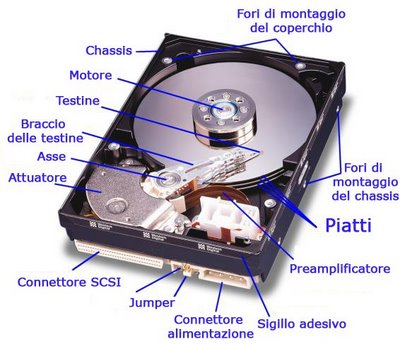2.5 inch Magnetic Disks
|
The two main formats that determine the size of the hard disks are 3.5 inch hard disk for desktop computers and 2.5 inch hard disk mainly used for laptops. The2.5″ hard disk precisely for their use in laptops, they are designed with the aim of consuming less energy, although sometimes at the expense of other functionality. The differences between 2.5" and 3.5" hard disk formats should not be underestimated. The 2.5" HD, in fact, they typically have less memory capacity, less cache and slower speed when compared to similarly priced 3.5" hard drives. |
|
|
|
For example, a 3.5″ hard disk can store over 12 TB (terabyte) of data, have more than 128 MB of cache and go from 7200 to even 10000 rpm. But the problem is that it typically consumes around 5W which it's ok for a desktop PC but is definitely too much for battery-powered laptops. A large 2.5" HD also reaches 4 TB, 16 or 32 MB of cache. The revolutions number for minute is usually 5400, but it can still reach 7200 and their consumption is lower, up to 2.5 W in some models. More the technology advances, more these data change but the thing that remains unchanged is the constant difference between the performance of 2.5″ and 3.5″ hard disks in the same price range. A 2.5″ high performance HD costs much more than a 3.5" high performance one, even if its performance is only comparable to a lower-end 3.5″ one. An advantage of 2.5″ hard drives, however, is their resistance to vibrations compared to 3.5 ones. For example, some 2.5″ hard drives have internal accelerometers that detect when they are about to fall, securing the disk head to minimize damage. This feature is rare for 3.5″ hard drives which are usually intended for desktop computers that are designed not to be moved when working. |
|
|
|
Thehard disk is basically made up of one or more rapidly rotating plates, made of aluminum or glass, covered with ferromagnetic material and two heads for each platter (one on each side), which, during operation, "fly" at a distance of a few tens of nanometers from the disk surface, reading or writing the data. The head is kept raised by the air moved by the rotation of the discs whose frequency or rotation speed can exceed 15,000 revolutions per minute; currently the standard rotation values are 4,200, 5,400, 5,980, 7,200, 10,000 and 15,000 revolutions for minute. ) The storage or writing of information or data on the surface of the ferromagnetic support essentially consists in the transfer of a certain direction to the magnetization of a certain number of Weiss domains. A bit of information (1 or 0) is associated with a certain state (direction) of magnetization. The number of Weiss domains that make up a single bit, multiplied by their average surface extension, compared to the available storage surface, provides the information density (bits per square inch). Therefore, cramming a greater quantity of data on the same disk requires reducing the number of domains that contribute to the definition of a single bit and/or reducing the area of a single magnetic domain. The continuous evolution of hard disk technology has now brought us close to the tolerable lower physical limit: when in fact the number of domains that define a single bit has approached unity and their area is of the order of a few square nanometres, the thermal energy of the system has now become comparable to magnetic energy and a very short time is sufficient to reverse the direction of the magnetization of the domain and lose the information contained. In the past, the reading/writing of magnetic information was entrusted to inductive heads, miniaturized copper windings capable of detecting, during the reading phase and according to the principle of magnetic induction, the variation in the flow of the static magnetic field as the head passes between one bit and the next of a track containing the bits, or in a dual manner impressing a magnetization on the disk being written. The evolution that spintronics brought into everyone's homes were the magnetoresistive heads, based on a device, the spin-valve, capable of varying resistance as the intensity of the magnetic field changed. The advantage given by these heads lies in their sensitivity, better than the old inductive heads, and in their very small size, which allows you to follow the pace of evolution towards the nanometer regarding the area of a single bit. Finally, the near future will see reading heads based on magnetic tunneling junctions, MTJ, as protagonists of the scene. |
|
|
|
Typically for the storage of digital data the hard disk requires the preliminary operation of logical formatting with choice of the particular logical data storage system to be used known asfile system, through which the operating system is able to write andrecovery data. |
|
|
|
The data, at the physical level, are generally stored on disk following a well-defined physical allocation scheme based on which the area where the data can be read/written on the disk can be reached. One of the most widespread is the so-called CHS, acronym for the English term Cylinder/Head/Sector (Cylinder/Head/Sector); in this structure the data is stored with a number as physical address for each of the following physical entities: Platter: a hard disk is composed by one or more parallel disks, called "platters", and each side of the platters is identified by a unique number; for each plate there are two heads, one for each of the two sides. Head: on each platter there is a head for each side of the same, for writing or reading access to the stored data; the position of this head is integral with all the others on the other platters. In other words, if a head is placed above a track, all heads will be placed in the cylinder to which the track belongs. track(A): each plate is made up of numerous numbered concentric rings, called tracks, each identified by a unique number. Geometric sector (B): each plate is divided into equal radial "slices", each identified by a unique number. Cluster (D): set of contiguous track sectors. Cylinder: the set of tracks at the same distance from the center present on all discs or platters is called a cylinder. Matches all tracks with the same number, but different plate. Block: The set of sectors placed in the same position in all plates.CHS, expressible by indicating cylinder, head, sector. In this way it is possible to uniquely address each block of data on the disk. For example, if a hard disk is made up of 2 disks (or equivalently 4 platters), 16384 cylinders (or equivalently 16,384 tracks per platter) and 16 sectors, and each sector of a track has a capacity of 4096 bytes, then the capacity of the disk will be 4 × 16384 × 16 × 4096 bytes, i.e. 4 GB. The interleaving factor is the number of sectors of the hard disk that must be skipped to consecutively read all those of the track. This strictly depends on the performance characteristics of the hard disk itself, i.e. the rotation speed of the disk, the movement of the seekers with their heads and the read-write speed of the head itself. This process was introduced because initially the CPUs, which received and reprocessed the read data, performed these actions at a speed lower than the reading/writing speed on the hard disk, therefore, once the data coming from a sector had been reprocessed, the head would already be beyond the beginning of the next sector. By alternating sectors regularly and reading them according to the specific interleaving factor, the hard disk and the computer were speeded up. Modern hard drives do not require interleaving. |
|
|
|
Thesectoris the smallest unit of the low-level formatting that concerns the physical structure of the hard disk (physical formatting not to be confused with the logical formatting that concerns the creation of the file allocation tables [FAT] necessary for the operating system to manage and navigate the data present in the disk folders). Generally, industries are logically grouped into clusters for efficiency reasons, so when we talk about clusters we are referring to a group of industries. Remember that a file always occupies at least one cluster. To access a sector you must specify the surface (platter), the track and the sector itself. The sector is not a simple space on the storable disk, but is also equipped with a particular structure which can be linearly summarized as follows (the size of a sector varies between 32 bytes and 4 KB, usually 512 bytes): <IRG><SYN,SYN><HEADER><DATI><BCC>. The IRG is InterRecordGap, that is, the demagnetized part of the trace that serves to announce the beginning of the sector (or its end). The part named "SYN,SYN" are known bytes for the read clock, i.e. they serve to synchronize a current read clock, generated by the combined PLL and VCO, with the original write clock. At the center is the "HEADER", part of the sector where the information necessary for locating the same sector on the entire hard disk is stored, i.e. where the head is reading-writing at that moment. Certainly the most important part is the "DATA" one, that is, where the data has been packaged through records so that the ratio between "useful" data and information is high: the data allocated in the sector must be greater than the allocation information of the sector itself. Another important part of the structure of a sector is the "BCC", block check character. This part of the sector is the result of a function calculated on the "data" block and its purpose is to confirm the correct reading of the information, i.e. the data, and to make clear any reading error. The commercial name Advanced Format has recently been introduced, all manufacturers apply a special irrefutably discernible logo on all hard disks that have sectors larger than 512 bytes using this common name. Each manufacturer adopts a peculiar structure for the individual sectors of the AF disks which contains, in addition to parts homologous to those described, a real CRC and other proprietary construction parameters depending on the model and intended use of the specific product. |
|
Do you have a problem with one of these devices?MrDisk is a Specialized Laboratory in Data Recovery equipped with all the necessary equipment to allow therestore lost data from any type of case presented to us.
In our laboratories only work specialized technicians with years of experience in the field of professional data recovery, to offer our customers the best possible service.
Some important features:
Total data recovery is possible in the following cases:
data recovery process in a clean room is divided into two steps: the diagnosis step and the data recovery procedure. The customer is constantly informed about the status of data recovery.
Request a free analysis by clicking on the page contattaci! |





.jpg)
